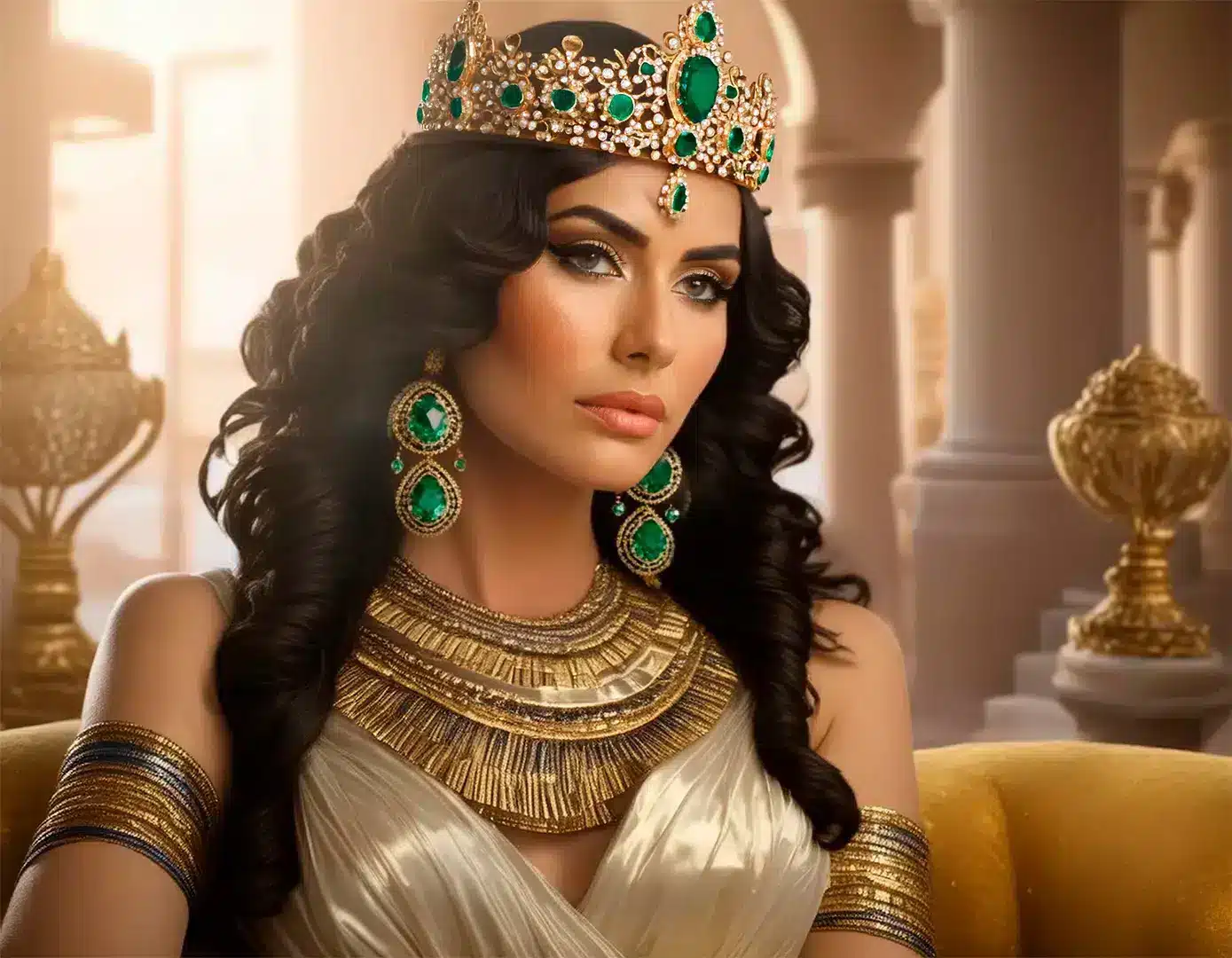The Fascinating World Of Emerald

“EMERALDS ARE THE MOST PRECIOUS OF STONES”
Once upon a time, in the ancient kingdom of Egypt, Cleopatra, the enigmatic and powerful queen, adorned herself with emeralds to symbolize her royal status and beauty. These lush green gemstones, believed to be gifts from the gods, were cherished not only for their mesmerizing color but also for their supposed ability to protect against evil and bestow wisdom upon their wearer. Cleopatra’s love for emeralds was so profound that she even claimed ownership of all emerald mines in Egypt, ensuring that her legacy would be forever intertwined with these precious stones.
Today, emeralds continue to captivate us with their rich history and stunning beauty. In this blog, we’ll explore everything you need to know about these beautiful gemstones, from their history to how to buy the perfect emerald for you.
Quick Summary
1. Description of Emerald
- What Makes Emeralds Unique?
- The Rich Green Hue: Chromium and Vanadium
2. History and Journey of Emerald
- Cleopatra’s Favorite Gem
- Medieval Beliefs and Uses
- Emeralds Through Different Cultures
3. The Age of Emeralds
- Geological Formation
- Historical Timelines
4. Most Expensive Emeralds
- The Bahia Emerald and Other Record Holders
- Historical Auction Prices
5. Treatments, Synthetics, and Imitations
Common Treatments:
- Oiling
- Fracture Filling
- Heat Treatment
Synthetics:
- Hydrothermal Process
- Flux-Growth Process
Imitations:
- Glass
- Green Cubic Zirconia
- Doublets and Triplets
6. Emerald as a Birthstone
- May Birthstone Significance
- Zodiac Associations: Taurus and Gemini
7. Why Love This Gemstone
- Symbolism: Renewal and Growth
- Unique Beauty and Historical Significance
8. Quality Factors
Cut:
- Importance of Emerald Cut
- Other Popular Cuts
Clarity:
- Understanding Inclusions
- Impact on Value
Weight:
- Carat Weight and Pricing
- Importance of Physical Dimensions
Color:
- Ideal Emerald Color
- Notable Sources and Their Characteristics
9. Sourcing Places
- Top Locations: Colombia, Zambia, Brazil, Afghanistan
- Unique Characteristics of Each Source
10. Hardness and Durability
- Mohs Hardness Scale
- Care and Maintenance Tips
11. Where to Get Emeralds
- Reputable Jewellers
- Online Retailers
- Gem Shows and Auctions
- Certification Importance
Conclusion
- Summary of Emerald’s Unique Qualities
- Invitation to Explore JewelNI’s Collection
JewelNI’s Emerald Collection
- Explore our Curated Selection
Description of Emerald
Emeralds are a variety of the mineral beryl and are known for their rich green hue. This color comes from trace amounts of chromium and sometimes vanadium. Their vibrant color and rarity make them one of the most sought-after gemstones.
History and Journey of Emerald
Emeralds have been cherished since ancient times. They were highly prized in ancient Egypt, where Cleopatra adorned herself with these gems. In the Middle Ages, emeralds were believed to have healing properties and were used to ward off evil spirits. The journey of emeralds through different cultures highlights their timeless appeal and the rich history associated with these stunning gemstones
The Age of Emeralds
Emeralds are a variety of the mineral beryl and are known for their rich green hue. This color comes from trace amounts of chromium and sometimes vanadium. Their vibrant color and rarity make them one of the most sought-after gemstones.
Most Expensive Emeralds
Some emeralds have fetched millions of dollars at auction. The Bahia Emerald, for instance, is one of the largest single emerald stones ever discovered, weighing around 752 pounds.
“Did you know that emeralds were once believed to protect against memory loss and enhance intuition? They have been symbols of rebirth and love throughout history.”
Treatments, Synthetics and Imitations
When it comes to emeralds, understanding the differences between natural stones, treated stones, synthetics, and imitations is crucial for making an informed purchase. Let’s delve into each category in more detail.
Treatments
Emeralds are often treated to enhance their appearance. The most common treatment is oiling, where oils or resins are used to fill surface-reaching fractures, improving the stone’s clarity and overall look.
- Oiling: This is the traditional treatment for emeralds, using natural oils (like cedar oil) or synthetic resins to fill cracks and improve clarity. Over time, the oil may need to be replaced as it can dry out or leak from the stone.
- Fracture Filling: Similar to oiling, this treatment involves using a transparent material (like epoxy or resin) to fill fractures. This is more permanent than oiling but still requires proper disclosure.
- Heat Treatment: Although less common, some emeralds undergo heat treatment to enhance their color. However, emeralds are less frequently heated compared to other gemstones like sapphires and rubies.
Synthetics
Synthetic emeralds are lab-created stones that have the same chemical composition, crystal structure, and physical properties as natural emeralds. They offer a more affordable option without compromising on the gem’s aesthetic appeal.
- Hydrothermal Process: This method mimics the natural conditions under which emeralds form, using high pressure and temperature. The result is a synthetic emerald that is virtually identical to natural stones in appearance and structure.
- Flux-Growth Process: This involves dissolving the starting materials in a flux (a substance that lowers the melting point) and slowly crystallizing them to form synthetic emeralds. These stones can sometimes have inclusions that are similar to those found in natural emeralds, making them harder to distinguish.
Imitations
Imitations are materials that look like emeralds but have different chemical and physical properties. They are often used in fashion jewelry and can be made from various substances.
- Glass: Green glass can be used to imitate emeralds. While the color may be similar, glass lacks the durability and brilliance of real emeralds.
- Green Cubic Zirconia: This is a synthetic material often used to mimic the appearance of various gemstones, including emeralds. It’s much cheaper and less durable than a true emerald.
- Doublets and Triplets: These are assembled stones made by combining thin layers of genuine emerald with other materials, such as glass or synthetic emerald. They are designed to give the appearance of a larger, high-quality stone at a lower cost.
Emerald as a Birthstone
Emerald is the birthstone for May, representing rebirth and love. It’s also associated with the zodiac signs Taurus and Gemini.
Why Love This Gemstone
Emeralds are unique due to their enchanting green color and their rich history. They symbolize renewal and growth, making them a perfect gift for loved ones.
Quality Factors
Cut
- A well-cut emerald maximizes its brilliance.
- The cut of an emerald refers to how it has been shaped and faceted from the rough stone. Unlike diamonds, which are often cut for maximum sparkle, emeralds are cut to minimize inclusions and maximize color.
- The most popular cut for emeralds is the emerald cut, a rectangular shape with truncated corners. This cut is designed to protect the stone from mechanical stress and showcase its color. Other cuts include oval, round, and pear shapes.
Clarity
- Inclusions are common in emeralds and can add character.
- Most emeralds contain inclusions, which are internal characteristics such as fissures, crystals, or fractures. These inclusions are sometimes referred to as the stone’s “jardin” (French for garden). While they are common and expected, their visibility and extent can affect the stone’s value.
- High-quality emeralds have fewer and less visible inclusions, which makes them more valuable. However, some inclusions are tolerated if they do not significantly impact the stone’s beauty or durability.
Weight
- Emeralds are measured in carats, with one carat equaling 200 milligrams. The price per carat increases significantly with size, especially for stones with good color and clarity.
- Larger emeralds are rarer and thus more expensive. Sometimes, the physical dimensions of an emerald can give a better indication of size than carat weight alone, especially if the stone has been cut deeply or shallowly.
Color
- The ideal emerald color is a rich, vibrant green to bluish-green with even saturation. The hue (the stone’s primary color), tone (lightness or darkness), and saturation (intensity of color) all play a role in the overall appearance.
- The finest emeralds are typically medium to dark green and evenly colored. Stones that are too light or too dark are less desirable.
- Emeralds from Colombia are renowned for their exceptional color and quality.
Sourcing Places
The finest emeralds come from Colombia, Zambia, Brazil, and Afghanistan. Each source has its own unique characteristics.
Hardness and Durability
Emeralds have a Mohs hardness of 7.5-8, making them durable but still requiring care to avoid scratches.
Where to Get Emeralds

Finding a trustworthy source to buy emeralds can be challenging, given the variations in quality and treatments. Here are some tips for sourcing your emerald:
Reputable Jewellers: Start by visiting reputable jewellers who specialize in gemstones. They can provide you with detailed information about the emeralds they sell, including any treatments the stones have undergone.
Online Retailers: Many reputable online retailers offer a wide selection of emeralds. Ensure the site provides clear information about the gemstone’s origin, treatments, and certifications. Look for customer reviews and ratings to gauge the reliability of the seller.
Gem Shows and Auctions: Gem shows and auctions can be a good place to find high-quality emeralds. However, it’s essential to have a good understanding of the gemstone and its value before making a purchase.
Certification: Always ask for a certificate of authenticity from a recognized gemological laboratory. This certificate will verify the emerald’s quality, origin, and any treatments it has undergone.
“for a curated selection of high-quality emeralds, we invite you to explore our website JewelNI. Our collection features emeralds sourced from the best locations worldwide, with detailed information about each stone’s quality and treatments. Our expert team is here to help you choose the perfect emerald, ensuring you get the best value for your investment”.
Conclusion
- Emeralds are truly mesmerizing gemstones with a rich history and unique beauty. Whether you’re looking to buy an emerald for yourself or as a gift, our site offers a curated selection that is sure to impress.
- By following this guide, you’ll not only learn everything there is to know about emeralds but also be inspired to add one to your collection. Discover the allure of emeralds and explore our exquisite range today!




